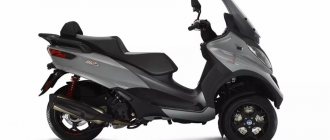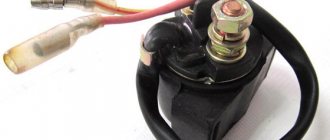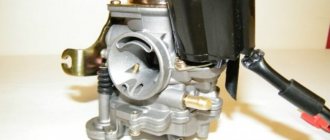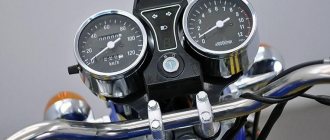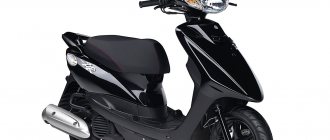Electric scooter Piaggio 1
It so happened that Piaggio, one of the pioneers of scooter manufacturing, was a little late in entering the electric scooter market.
First, they tried to skim the cream off this market with the release of the conventionally top-end Vespa Elettrica, which in fact turned out to be of interest only to fans of the “green” lifestyle, because neither the performance nor the range of the first all-electric scooter from Piaggio could stand any comparison with gasoline models, even urban. Then there was a short pause, during which the Elettrica was slightly updated and acquired a couple of configuration options, but it turned out that Piaggio at that time was quite seriously thinking about its future plans, reconsidering both its vision of the target audience of the new products and positioning in the price category. The result of this was the Piaggio 1 scooter, which combined the features of European design with the cartoon style beloved in Asia, and was light and compact with a power reserve and recharging speed sufficient for the city (and acceptable for this price category).
Piaggio 1 electric scooter.
Initially, Piaggio 1 (or Piaggio One) was presented at the Beijing Motor Show, but before fans of the brand began to lament this, three variants of Piaggio 1 entered the European market, positioned in different categories of driver's licenses. Thanks to the right price, electric scooters are selling like hotcakes, and it looks like the Piaggio 1 will be the first European electric scooter that will attract interest not only from ordinary urban scooter riders, but also from the Xbox generation. Just think: a quality urban electric scooter from a major manufacturer starting at €2,690.
At the beginning of 2022, several accidentally leaked (or cleverly leaked) spy photos of the Piaggio 1 electric scooter appeared and its design was obviously and undoubtedly taken from the urban model Piaggio Zip. This is a simple and affordable mass-produced model, lightweight, excellent handling, and very popular. There are even still races on Zips, because these babies lend themselves well to tuning, but, unfortunately, the time of city gasoline mopeds and midi-scooters is coming to an end. On the one hand, they are being pressed by economic regulations, and on the other, by electric scooters, which are cheaper and can carry you quite quickly. However, electric scooters have served electric scooters very well: they introduced the audience to electric traction and at the same time turned city authorities against them so much that in many European cities they are simply confiscated for driving on the roads. So young people understood the beauty of eco-friendly and quiet riding, but the smartest of them quickly realized that, given the availability of a completely legal, quite nice and affordable alternative, scooters have no place on the roads. But scooters with internal combustion engines are also slowly becoming obsolete, because in cities there are increasingly zero-emission zones - that is, places where you can only drive on electric power or on a hydrogen internal combustion engine. The world is changing rapidly, and electric propulsion instead of fossil fuels will solve the issue of city driving, at least for the coming years
Piaggio 1 electric scooter.
Brand history
The iconic brand was founded more than a hundred years ago, in 1884, in Genoa. The company specialized in shipbuilding and wood processing for shipbuilding. In 1916, the son of the company’s founder, Enrico Piaggio, Rinaldo, became the general director of the brand and opened the aviation vector of development.
In 1924, Rinaldo acquired his own plant and began independently producing aircraft according to his own designs and licenses. The unprecedented rise of the company leads to the expansion of its activities, and now trailers, buses, funiculars and trams are produced under the brand name.
During World War II, Piaggio produced bombers and other military equipment, and after the war began rebuilding the plant. The idea of fixed designers was to develop a budget vehicle. The result of the development is the Vespa scooter, which has become a legend. Compact shapes, low fuel consumption, frameless design and ease of maintenance made this scooter the ancestor of all European design schools.
In 1948, the plant's engineers began work on the Piaggio Ape scooter, which became the next breakthrough for the world market. In 1964, there was a split between company representatives. And in 1965, after the death of Enrico Piaggio, the concern was headed by Umberto Agnelli, under whose leadership the development of the first motorcycle began.
In 1988-1990, Piaggio created the Sfera scooter with a plastic body kit.
The year 2000 was marked for the company with the opening of its first store in the USA. Inspired by the success, the management of the concern invests about 15 million euros in the project of a new motorcycle, which turns out to be unsuccessful.
After significant upheavals and even the sale of part of the shares, the company signs a strategic agreement with the Chinese concern Zongshen. Success in the Asian market leads to the creation by Piaggio of the Vespa XL scooter, which became the 139th generation of the legendary Vespa.
The Piaggio 1 electric scooter line currently consists of three models.
Basic electric scooter Piaggio 1
The basic version of Piaggio 1 is equipped with a 1.2 kW wheel motor and a 1.4 kWh battery, and is comparable in performance to a moped, that is, it can be used in many places without opening a motorcycle category of driver's license. The cost of this option in Britain is 2,500 pounds, but they have a government subsidy for the purchase of electric vehicles, so the actual price at the moment will be 2,011 pounds - that’s about 195 thousand rubles at the current exchange rate.
The basic version has a range of up to 55 km in Eco mode and up to 43 km in Sport mode, its speed is limited to 45 km/h to comply with the moped category. Not much, but more than most mopeds travel in a day.
Electric scooter Piaggio 1+
Piaggio 1+ is equipped with a 2.3 kWh battery and is capable of driving up to 100 km in Eco mode on a single charge. The 1.2kW motor (1.35kW peak) is similar to the base version, and this version weighs 90kg.
Electric scooter Piaggio 1 Active
The Piaggio 1 Active is equipped with a 2-kilowatt motor, and although the power of this engine does not exceed the limits of the M category, the scooter is capable of speeds of up to 60 km/h , electronically limited, and therefore requires a motorcycle category to operate. The Piaggio 1 Active has a range of 80+ km in Eco mode or 50 km in Sport mode. Active costs 3,000 British pounds, but taking into account government subsidies it will cost 2,411 pounds ( about 235 thousand rubles ).
Unfortunately, at the moment there is no version equivalent in power to a 125 or 150 cc internal combustion engine, and in terms of power reserve, all three babies are not yet capable of surpassing the average city gasoline scooter. But perhaps this is not necessary?
Pros of the Piaggio MP3 500 scooter
Despite the considerable weight, the engine power is enough for a brisk start from a traffic light, and the traffic easily remains behind. The significantly redesigned half-liter engine pulls perfectly at any speed up to the cutoff, while its predecessor also had good traction, but was suffocating at high speeds. Now it spins up to 7000 with ease.
As mentioned earlier, the MP3 500 will be supplied to the global market in two versions: Business and Sport, and to the US market - only in the Sport version. The main differences are in the finish - black wheels on the Sport and silver on the Business version. However, the Sport version will also get Kayaba gas-assisted rear shock absorbers and wave front brake discs.
The braking system, by the way, is excellent. Two 258 discs at the front, one at each wheel, and a 240 disc at the rear, plus ABS. The set of electronic features also includes ASR traction control and the Piaggio Multimedia Platform, which transmits a group of device operating parameters to the smartphone screen.
The Piaggio MP3 is a very comfortable and original city scooter , perfect for both high-speed cutting through traffic jams and riding on the stone pavements of European cities, and its stability and powerful brakes add reliability and confidence to daily trips on it.
Some details about Piaggio 1
The Piaggio 1 comes in six color options, and the Forever White we tested turned out to be surprisingly well-made, high-quality, and pretty. White scooters often look downright pale, but the white trim elements of the Piaggio 1 contrast very well with the black glossy wheels, the dashboard frame, the inside of the front shield, and the wing of an interesting design. Small relief details on the surface of the cladding give it a finished look, and the LED light with DRLs of an interesting shape and built-in turn signals emphasize that the design of the scooter is not tied to any one era.
The full-color information panel has several layout configurations, including a single-color day mode and a colorful night mode, which changes automatically depending on the brightness of the surrounding lighting. The dashboard is pleasing to the eye and informative, although there are not as many important parameters on the electric scooter as on models with internal combustion engines.
The scooter is equipped with a USB socket, a traditional European luggage hook for shopping bags, and the underseat space, unexpectedly for an electric model, has free luggage capacity not occupied by the battery. The battery is there, but located deep in the frame, and can be removed for charging at home (which takes six hours) or charged without removal. The charger is placed nearby, along with an anti-theft chain and a rain cape, and an open helmet can also fit into the empty compartment.
Other color options include Forever Black, Forever Grey, Sunshine Mix, Blue and White Arctic Mix and Forest Mix. Traditionally for Piaggio, the lining can be removed quite easily, and third-party manufacturers will certainly soon offer additional color and design options.
Electric scooter Piaggio 1
Piaggio 1 in the city
In the scooter's natural habitat - city streets - you quickly realize that the electric riding modes are actually useful, even if the top speed is limited to 60km/h.
Eco mode is obviously designed to save energy, and it limits power slightly. In this mode, the scooter reaches up to 30 km/h, and this is quite enough for a quiet ride in traffic. With a press of a button on the right remote, it switches to Sport mode, where full power is available, but at the cost of range. Of course, most riders will prefer this mode. The convenient reverse function (at a snail's pace, of course) makes maneuvering in parking lots easier, and the near-silent ride creates a fun feeling of calm that has little in common with vigorously riding a motorcycle with a loud exhaust.
Chassis.
Just when it seemed that two-stroke engines were a thing of the past, Piaggio pulls one out of its sleeve. One cylinder, air cooling, volume 49.4 cm3; the cylinder diameter is almost equal to the piston stroke: 40 mm and 39.3 mm, respectively. But the main role here is played by the new induction control system. The electronic carburetor controls the air-fuel mixture via a new solenoid valve rather than a manual throttle valve. It is thanks to the electronic intake that the engine meets exhaust gas requirements and meets the Euro4 standard. The new exhaust system includes a dual catalytic converter and a dual secondary air injector to burn free hydrocarbons. Thus, the exhaust gases become almost clean. Yes, for the smallest engines the requirements are not so stringent. But still, today a two-stroke engine that meets emissions requirements commands respect. Typhoon is equipped with a push-button start as well as a traditional kick starter for emergency situations. Although sometimes the emergency is that you desperately need to look cool. The engine produces 4.1 hp at 6500 rpm and 4.6 Nm of torque at 6000 rpm. The centrifugal clutch and continuously variable transmission deliver power without the need for an intermediary: the clutch or gear lever.
Piaggio 1 on the go
The Piaggio 1 Active feels most like a good old-school moped with all the chokes removed.
There was a blessed time in Europe when restrictors that limited power and speed were installed in the most obvious places and marked on spare parts catalogues, so they were literally removed at home, revealing previously inaccessible speeds. So the Active, which quite easily reaches 60 km/h, allows you to stay in the flow more confidently, and from a traffic light it goes ahead quite easily, accelerating much more vigorously than most 50 cc scooters, and it generally reaches 45 (the maximum speed for legal fifty dollars) in the blink of an eye. The price of this vivacity is an additional 500 pounds and the need to open category A1/A. Moreover, in many places in Europe, mopeds have long been required to ride “with license plates” and with insurance, except that they have not yet passed technical inspection, so it will no longer be possible to pass off the older version as a basic one by removing the license plate.
There are many nice aspects to the Piaggio 1, but the main one is this: it's reasonably priced without feeling like it's been skimped on. For example, it is equipped with keyless ignition, which motorcycle manufacturers have long been trying to pass off as a premium option (although in fact, keyless access is no fundamentally different from the ubiquitous immobilizer). Both wheels are equipped with disc brakes (the rear one, i.e. the left handle is a combined one), and in addition, the scooter is equipped with a KERS recovery system, which slightly recharges the battery during braking. The suspension configuration will be unusual for a modern motorcyclist - there are two struts at the back, and a single-sided suspension instead of a fork at the front, but fans of classic scooters will easily recognize the characteristic single-sided cantilever suspension, traditional for Vespa and many other Italian scooters (and successfully borrowed by the Japanese for several pseudo-classic models ). The dashboard is also modern and doesn't look budget at all, the finish is superb and even the molded swingarm is nice to look at. Many e-scooters look like garage projects where aesthetics are pushed aside in favor of technology and the swingarm is made from a rectangular profile tube, but Piaggio have made their brainchild not only affordable, but also cute, and that's worth a lot.
Design.
Piaggio retained the most recognizable feature of the Typhoon family - the sharp nose. The familiar look is complemented by a dual headlamp design with four vents on each side. Gold-colored brake calipers peek through the completely black rims. This color scheme is supported by the front fairing and forks. One of the goals of Typhoon scooters is to attract attention to the driver. For this purpose, there are stylish stickers that support the sporty design. The 2022 generation is no exception. The stickers fit well on the body panels. But it is doubtful that they were really needed, because the bike simply does not have large areas that need to be visually divided. But at least Typhoon looks less official. Behind the typically Italian steering wheel you can see a dashboard with an analogue clock and speedometer, LCD screen and other indicators. There is no tachometer, but there is a fuel gauge and there is no need to rely on the odometer. There is a flat floor under the driver's feet—there is no tunnel, so boarding and disembarking occurs without any hitches. The new seat is covered in smooth fabric. If you fold it back, the luggage compartment opens, in which an integral helmet can fit. There is also a USB connector, so you can also charge your gadgets on the go. The subframe is raised slightly and forms the rear seat. The passenger will be comfortable, because there are footrests and a handrail. The rear view is completed by an LED taillight, mudguard and license plate surround. The new muffler casing slightly changed the appearance of the power plant. Overall, Typhoon is, as usual, a special embodiment of youth enthusiasm.
Results
In general, the Italian motorcycle giant has challenged other manufacturers. Yes, there are other markets whose strong positions are more prestigious, but if it is possible to create a high-quality and attractive scooter at such an affordable price, then why not do it? And they succeeded quite well. For those contemplating going electric or upgrading altogether and looking for something cost-effective and zero-emission, it makes sense to contact your local Piaggio dealer to see if the Piaggio 1 will be on sale.
In Europe, the babies will go on sale in November, and there are probably already small queues lining up for them.
Cons of the Piaggio MP3 500 scooter
The only negative point is the location of the brake pedal. It is only there because of the bureaucrats, because in order for the MP3 to be homologated for riding without a motorcycle category, it must have a coaster brake. However, the brakes of the device are much more convenient to control using the levers on the steering wheel, so in practice this pedal is completely unnecessary. Its position is extremely inconvenient, since it is located directly under the toe of the right foot, and for a comfortable ride you have to put your foot back a little, as a result of which it is not possible to brake quickly with the pedal.
